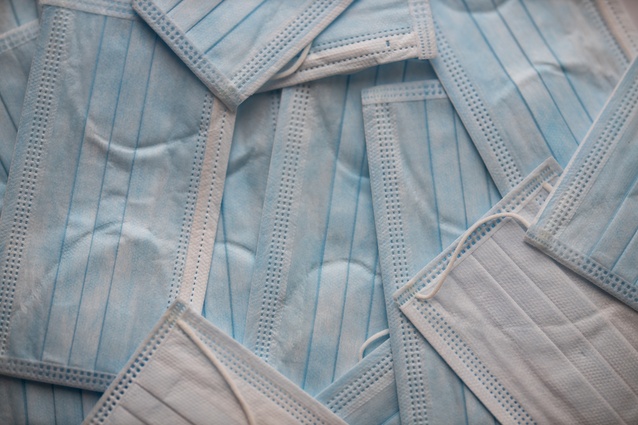Editorial: Chris Barton on COVID-era architecture
For me, it began with negotiating the way to wear a mask without my glasses fogging up. It took me a while to work out the best way of closing the gap at the top. There are lots of DIY tips – twist ties at the top seam, tape, a folded moistened tissue, a layer of nylon stocking for a snug fit.
Blurred vision banished, the mask sparked a new attention to the spatial dimension of the COVID-19 virus. It began as a binary mask-on, mask-off grading of situations, then a questioning of what sorts of space can become infectious. In making masks mandatory on public transport at Level 2, the government has given architects a first answer: the tubes of buses, planes and trains. The case at the Rydges Hotel also tells us to be wary of lifts.
If those types of space have the potential for infection, shouldn’t similar-sized spaces of containment, such as offices, shops, restaurants and bars also have a mask-on requirement? Professor Nick Wilson of Otago University’s Department of Public Health certainly thinks so. He calls for masks in all crowded public places and sees bars and clubs as the riskiest: “The key thing is often the music is loud so, often, people are talking loudly and they’re often in close proximity”. Infection by loud, close talking. Think of the last time you tried to have a conversation in a fashionable restaurant.
Proximity is clearly a factor. So is the air that we breathe. On 6 July, some 240 clinicians, infectious-disease physicians, epidemiologists, engineers and aerosol scientists outlined, in the journal Clinical Infectious Diseases, mounting evidence that COVID is spread not only by touch and droplets sprayed from the mouth and nose, but also via another infection pathway – tiny airborne particles of liquid and material, known as aerosols, that stay suspended in the air for a long time. The air that we breathe. On 9 July, the WHO reluctantly agreed with the signatories, saying that more research is needed “given the possible implications of such [a] route of transmission” but acknowledging that short-range aerosol transmission cannot be ruled out in crowded, poorly ventilated spaces.

In Nature, researchers used a tracer gas to show how aerosols carried on currents from an air-conditioning unit in a restaurant in Guangzhou, China, were to blame for an outbreak affecting 10 diners from three separate families. Staff and patrons near other air-conditioning units were not infected. Another study in May used laser-light scattering to detect droplets emitted by healthy volunteers when speaking. One minute of loud speaking generates upwards of 1000 small, virus-laden aerosols, four micrometres in diameter, which remain airborne for at least eight minutes. Other studies show that aerosols can remain aloft in air and travel tens of metres, much greater than the scale of a typical room, while settling from a height of 1.5m to the floor.
For architects, there are some immediate implications. Passive ventilation – openings, such as windows and vents, not only to let fresh air in but also, potentially, to let virus air out – suddenly becomes essential. So does minimising and possibly regulating against recirculating air, particularly in public buildings, workplaces, schools, hospitals and aged-care homes. Should such spaces also have high-efficiency air systems to filter out particles or use germicidal ultraviolet light to kill airborne viruses?
Some businesses, such as Marlaina’s Mediterranean Kitchen in Seattle, are already installing ceiling ultraviolet systems, described as blue-glowing “killing zones”, to wipe out viral aerosols and protect diners. Such installations need to be handled with care, as direct ultraviolet germicidal light (UVC) is not safe for people. But concentrated UVC is now on the front line in the fight against COVID-19. In China, the ghostly blue light is used to disinfect buses and squat, UVC-emitting robots have been used to clean hospital floors. Banks have apparently been using the light to disinfect money.
The jury is still out on the efficacy of the disinfectant of sunlight but some preliminary studies are compelling. Forbes reports that, when researchers exposed SARS-CoV-2 in simulated saliva to artificial sunlight (equivalent to a sunny day), 90 per cent of viruses were inactivated within seven minutes. This suggests your risk of exposure is significantly lower in outdoor environments.
All of this messes with your head. The space needed for social distance is defensive – taped lines and plexiglass barriers segmenting the outside world into safety zones. We retreat and hunker down indoors, seemingly safe within our bubbles. Now, basking in the sun in the great outdoors constitutes a new safety zone.
The idea isn’t new. Phototherapy helped reduce the impact of the 1918 flu pandemic caused by H1N1 influenza A virus. The effects of such healthy obsessions on architecture can be profound. Beatriz Colomina, Professor of Architecture at Princeton, argues the sanatorium was the laboratory of modernist architecture – that it was shaped by the 20th century’s urgent medical engagement with tuberculosis and the tool for its diagnosis, the X-ray. This heralded a new way of thinking about bodies and spaces, insides and outsides, health and architecture.
Colomina says much of modernist architecture can be understood as a consequence of the fear of disease. A prime example is Alvar and Aino Aalto’s 1929 Paimio Sanatorium in Finland – designed as a medical instrument and optimised to the smallest detail for hygiene and quiet. Its wide terraces provided air and sunlight for patients to take the ‘lying cure’.
In a world already beset with a bureaucracy of health and safety regulations, it’s more than likely COVID will build on this mode of control. Just what that creates – COVID-era architecture – is a work in progress. Inevitably, it will change thinking about our stock in trade – space.
The challenge for architects will be transforming space that is now necessarily pragmatic – clean air to breathe – into something that also deals with fear: something inspirational and uplifting.










